Artwork for music record, Kokodrilo´s “Silicon Bala” (2022)
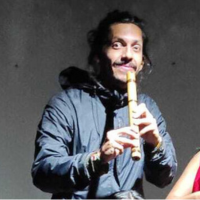
Martín Sánchez Martínez
artist and musician
Martín Sánchez Martínez imagines music with multiple friends and allies, including Los Niños Telepáticos, Rizomagic and 1280 Almas. He just started a new hermaphrodite rural punk band named “El Cholo Manjares,” where guitar and words combine devotionally in praise of home-made nourishment, inter-species kinship and everyday magic. This new musical project adds a new chapter in his artistic endeavor as a vessel, visionary, and amplifier, gravitating around intersections and solo adventures in the realms of documentary making, photo-journalism, multimedia installations, radio production, and illustration, practices through which he fosters “interdimensional synapsing among peoples” through art. Get in touch with Martín at martinsanchezm@nelisglobal.org
INTERVIEW
You’re an artist and a musician. What were your motivations behind embarking in these paths? What has the journey been like coming into your own voice and perspective? How would you describe your art, actually? And what does it mean to you? How has your music and art evolved over time?
Uepa, those are a lot of questions! I guess music, books and films have always been part of my life. Theater, for example, I remember inviting my family to puppet shows I arranged at home as a child. And if I go really far back, I remember already loving dancing and drawing at that point. I think I was always stimulated by my family to be very in touch with my senses and feelings, a very great gift they’ve given me. I am the youngest of three, both my parents are psychologists, and both my older brother and sister artists as well, so you get the picture. My dad, he is a natural actor, and a troubador in his own way. Every once in a while, I still have this memory where he would play the guitar and serenade my mom with boleros and ballads in the kitchen.
I believe both my parents instilled in me a sense of social justice and a critical spirit. My mom spent May ’68 in Paris; my dad was in Chile during the 1973 coup. He even spent one night at the National Stadium! I’m very lucky to be here, right? So yes, they taught me the importance of knowing myself and getting to know my history to know myself. I guess as I grew up, and gradually came to understand “how life can be so beautiful and yet the world so f*cked up” (as a dear friend once put it), it was clear I had to choose a creative path that could somehow contribute to the dismantling of it all, the Great Lie, as Cortázar somewhere puts it.
Perhaps then the evolution for me has been the active work of merging spiritual practice with material crafting. You know? I really find art has to do with meaningful experiences and transformation, hence the closed space it holds with what can be called magic and what can be called medicine. I think that possibility of consciously performing into matter, time or space, that alchemy by which nature speaks its own language, is something inherent to existence itself, not only to art. Like Mallarmé said I think, how he dreamt a poem made up of every single word a person says in his life.
I believe that defining what is and what is not art can sometimes be a fallacy. I like other definitions of art better. Those that are closer to the everyday experiences we share and live and the poetics we can see them through. Life as the true motherfunkin’ art. From thereon, the scope of possibility has been very wide for me and the ways in which I create and act. It is very hard for me to define “my” art, but I guess one can thread my doings, whether it is engaging through a camera, a drum or a cooking pot. Behind it all lies the believe that I can be a channel for love and can honor it with my thoughts, actions and words.

Screenshots from “Recuerda usted quién es Carlos Pantoja” (2015), a short film made and displayed for his campaign running for Nariño’s public assembly
In Colombia, you co-founded Hermanos Brothers, a production company powering social transformation through the arts. Now, you’re also NELIS’ Art Director. Could you speak more to what has led you to get involved in these projects and the key ideas that have inspired your work in both organizations?
Hermanos Brothers was from the beginning conceived as an interdisciplinary artistic laboratory from which diverse collaborations and participatory processes could grow, under the common purpose of nurturing deep affective and collective awarenesses and transformations.
What started as an invitation to design a logo and a poster for a binaural musical theater piece about an apple tree saved from deforestation by her bee friends, later evolved into a much deeper conversation on the crisscross of pedagogy, media communication and social organization. Hermanos Brothers then emerged as a collective experiment in entrepreneurship. Thinking about it now, I realize that maybe it really was the manifestation of an old concern my brother and I shared on how to find freedom in ourselves and in the world. Remembering to make of that quest a celebration.
There was one very dear project we developed questioning memory and migration through a partly fictional music play, La Balsa (The Raft). It was very emotional and I think it made all of us involved witness the tremendous power that articulating and listening to our life stories can have and the unavoidable need of doing so if we want to speak at all about peace. We also worked and played intensively with children and that was also “overhumongously” inspiring to really dig into horizontalities and power relation deconstructions, mutual teaching dynamics and knowledge ecologies. Childhood is a natural re-codification potency, and the wisdom to nurture in the sense of allowing sprouting from within, is very much needed today. We have much to unlearn about parenting and how we relate to others and children are great teachers.
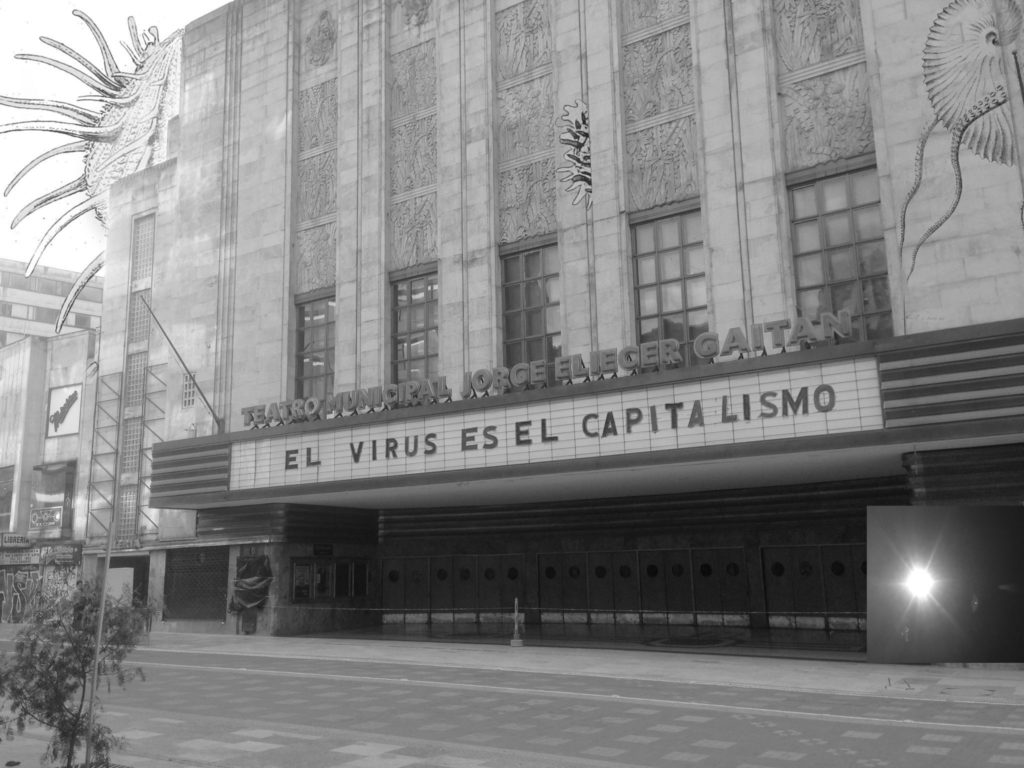
“Capitalism is the virus” (digital collage)
This eventually led to the making of Brave Now, World. Again, a choral-narration. This time in a documentary/video essay format, and that was the entry door to NELIS. I think that what seduced me from the very beginning and continues to do so about this global gathering of beautiful peoples is the belief in dialogue and diversity as being at the heart of any legitimate proposal for a better world.
Looking inside our local wisdoms, our family heritages and indigenous practices, and at the same time looking across other localities and experiences and really trying to bridge idiomatic gaps to find common philosophies, technologies and partnerships makes sense to me, politically and aesthetically. I find the glocal a very interesting and fertile tension. This organizational methodology, NELIS, works for mutualistically interconnecting communities within communities. It is a cause worth fighting for and deserves all my support and creativity to make it happen.
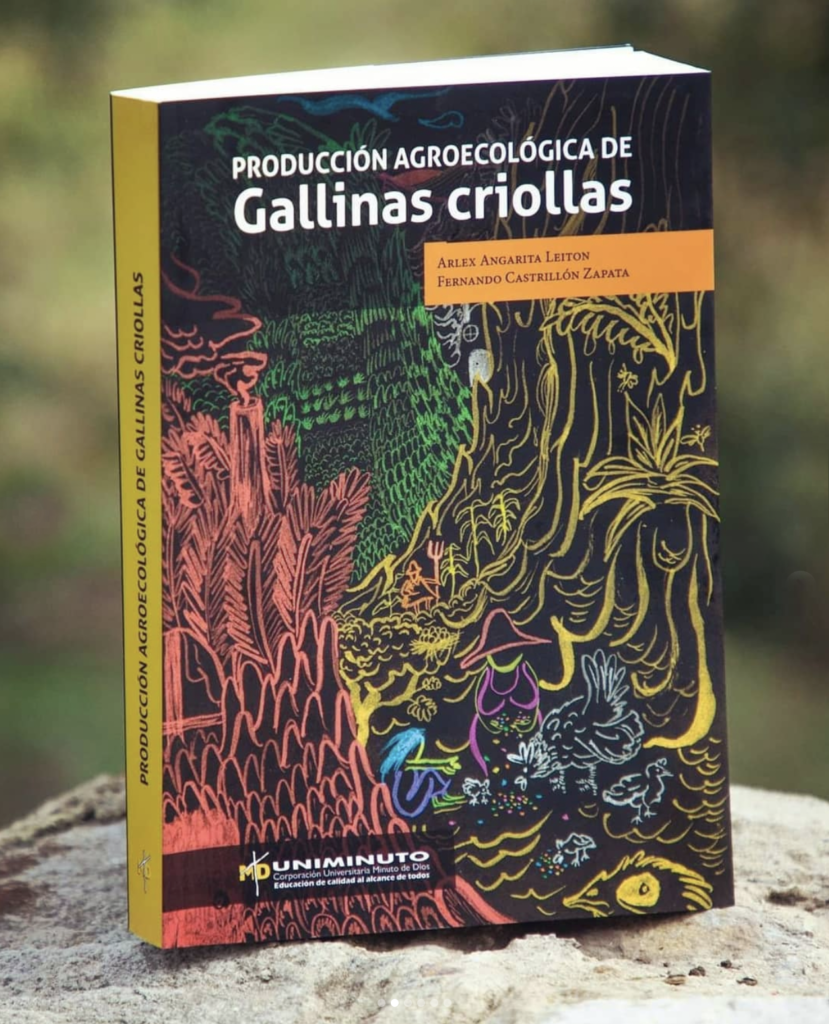
Illustrated book cover
Can you share reflections on the importance of the arts in achieving social transformation, youth empowerment and environmental regeneration?
Among the many ways the arts reincarnate themselves is research-oriented art, which has come to a very vivid and lucid moment where it is questioning its identity and place in relation to other disciplines and sciences and is finding potency as an agent capable of intervention. As a safe space for the uncertain, it offers the possibility to imagine and try other configurations not currently in existence and so can render possible new ways of being.
Lots of interesting processes and methodologies have been mining the landscape of this truly experimental and anti-insular understanding of the arts, reforesting cultures and working hand-in-hand with communities, addressing specific violences and needs and activating ways to seed alternatives. It’s not a coincidence that the recent social outbursts in Colombia coincided with the strengthening of independent radio programs, cultural get-togethers of all sorts and general artistic manifestations in the streets and on screens.
I’m no philologist, but very roughly, “poetry” comes from the Greek poesis, which is the ability “to create”. Finding the forms of the worlds we imagine requires the forces of art. “It is difficult to get the news from poems, yet men die miserably every day for lack of what is found there,” wrote William Carlos Williams. Art has always defended the intelligence of our hearts. Acknowledging that alone can help us think together more clearly, be more empathetic, show solidarity, and eventually shed history’s atoms as changes in our laws, economies and motherlands unfold.
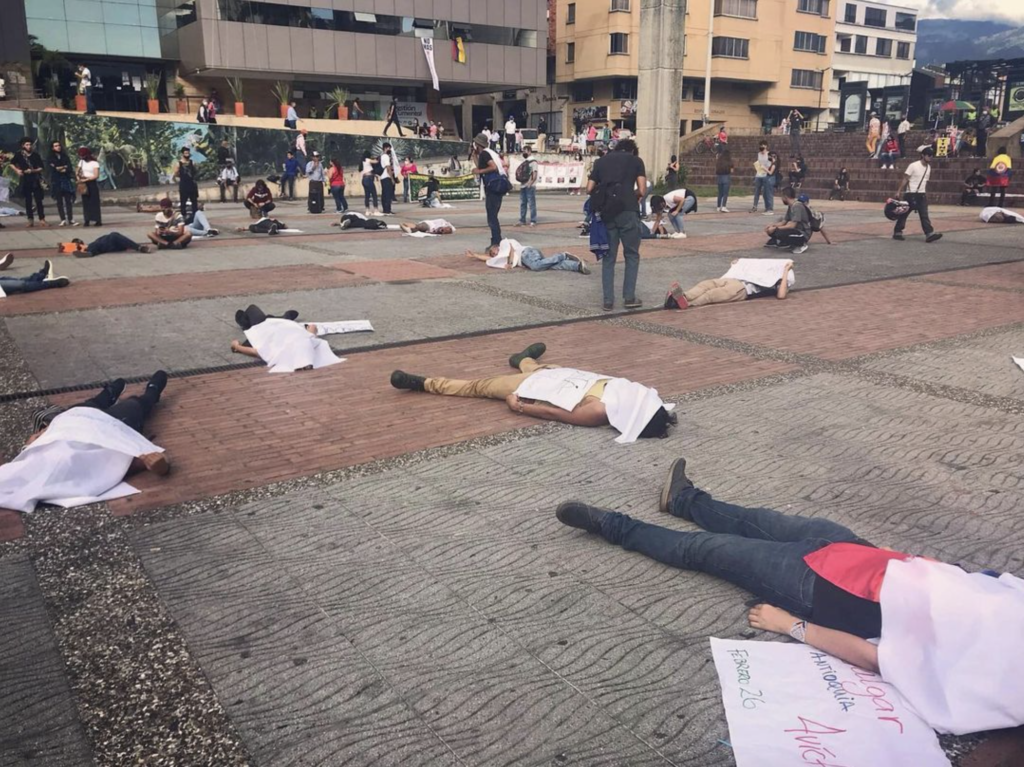
Popular performance protest in Armenia’s main square (2020)
When I see your work, I see much symbolism and specificity tied to local cultures and the land. Most of the time, colors seem to play an important role also. Can you tell us about what it means to work with all these elements?
I don’t know, symbols and stories are everywhere. It’s just a matter of what you want to pay attention to. I do know colors are symbolic, for cultures wide and far, but also on a personal level, right? How you dress, or how the food you cook looks, or just how you love a place due to how the light feels there.
When making images they work for me like windows where those colors can come in and then travel, through time or space, with those diverse meanings within. I love traveling and recognizing my being in unknown ways, as well as discovering meanings and sensations others have encountered. I sometimes doubt my memory, so I also try to make things to remember those findings.
But yes, when commissioned to portray a subject, place or story, it is very important for me to really learn about it as much as I can. I believe only from that complicity and intimacy can a proper and respectful image come to be. But it is all very instinctive to me, you know? I think the evolution as an artist you ask me about has to do with this fine-tuning of my instincts, this ability to connect that can allow the true stories and intentions behind an image to decide what guides its proper light.

Working on a short-documentary poster my cousin Santiago Caicedo Torres made in Brussels about a Colombian woman exiled there
NELIS’ latest project is the One Million Leaders (OML) App, a tool to empower young sustainability leaders and connect the global social change ecosystem. The app is also quite an artistic statement. What inspired the visual experience that we see today? What were you aiming for and where do you see it going?
Well, I remember creating the first visual approaches while visiting a friend down south in Colombia, in Sibundoy, a really magical place. The vibes there certainly influenced that emerging bud. And then Peter David’s friend in Denmark, Bo Linnemann, joined the project, and the opportunity came for me to go over there and work with him on the app’s aesthetics. I felt so lucky and excited! Never had I visited Europe! So I really wanted to have both this flux from Kontrapunkt’s finest Danish-Japanese design sophistication, in tandem with a more southern flavor… maybe rougher, maybe just loose. It’s hard to define!
The core values and concepts that the OML app holds – transparency, honesty, horizontality, communal empowerment, “dirt under the nails” – made me think of popular education and popular graphics, vernacular non-academic “patois.” As a digital interface, the app had to reflect the humanness and crafty sense of the project. Also, a very earthy and vivid color palette, which is pretty much the essence of NELIS’ branding, actually designed by the Brazilian team at the time.
So just before heading out to Copenhagen, I was living on the most beautiful farm in the countryside, and I was very focused on conjuring all those frequencies of greens and yellows of lichens, fruits and leaves onto the screen. And then, there was also this aura of primitive tech, 8-bit simplicity, sort of that open-code early internet anarchist utopia emotion. Back to basics, right? So yes, I tried to infuse all these elements into what I want to believe is an ongoing process that’s mutable, traversed by interculturality and an inclination to connect and empower organizational processes around the world. I hope for it to gradually be more and more community-led, community-programmed and community-sustained. The real paleo-futurism!
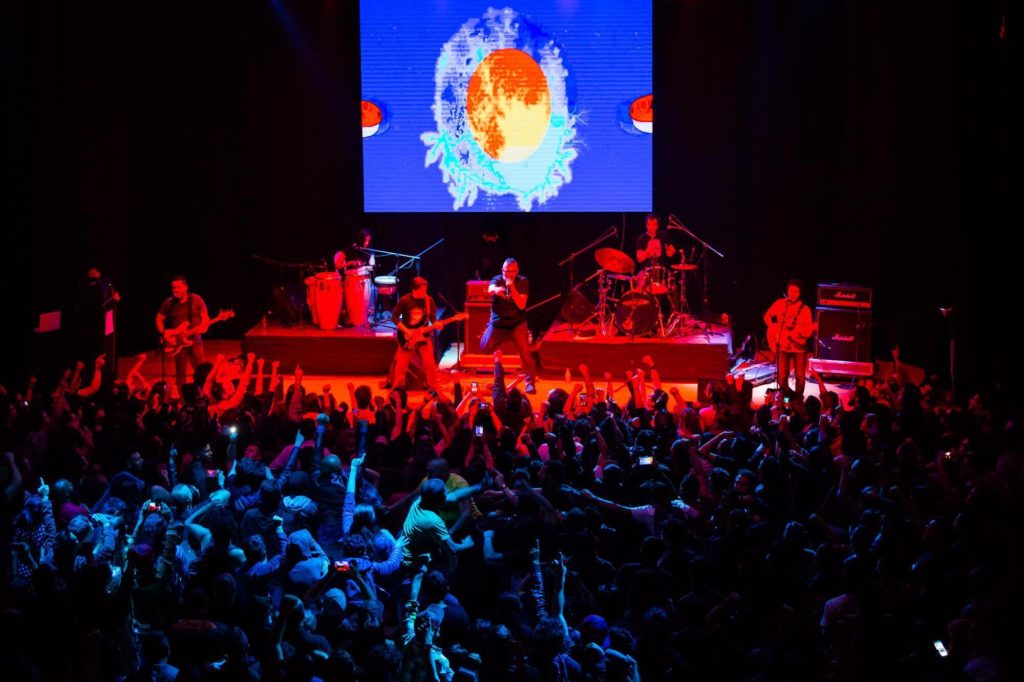
Live performance with 1280 Almas
What’s the ultimate goal? What are are you excited about enabling in NELIS and the world with your art?
The ultimate goal? I guess the dream is someday for the planet to become a free land body again. My intention is to walk in that direction, no matter how small the steps, or how many stops to take a look at the map are needed. This I think is rooted in a belief in the power of dreams. To be honest, I struggle a lot to remember my dreams and bring them into consciousness and to integrate them into my life to dissolve or unify.
I guess I just want to contribute to that communal process, and be able to foster a contagious ethic of care in our relationships through my actions, decisively but very humbly. I was learning about the concept of “effective love” coined by Camilo Torres, a priest that fought in the guerrilla in the 60s here in Colombia, all of it actually inspired by a song by an artist I admire very much too, Edson Velandia, who wrote about him. I found it very accurate how he could only conceive of love as “effective” when it really considered his kin’s self-realization as part of his too. When you care for something or someone, you want to see them flourish.

Web flyer for La Balsa (The Raft), a musical theater play produced by Hermanos Brothers
Is there anything you still want to say about your work, and the arts and the role they play in creating a better world?
I’ve always loved a written fragment from Philip K. Dick’s Valis, that appears collaged in the booklet of a CD my sister passed on to me from a local band here in Bogota, a band close to my heart which I would end up collaborating with many years later! It reads: “Who had built the prison -and why- he could not say. But he could discern one good thing: the prison lay under attack. An organization of Christians, not regular Christians such as those who attended church every Sunday and prayed, but secret early Christians wearing light-grey robes, had started an assault on the prison, and with success. The secret: early Christians were filled with joy.”


